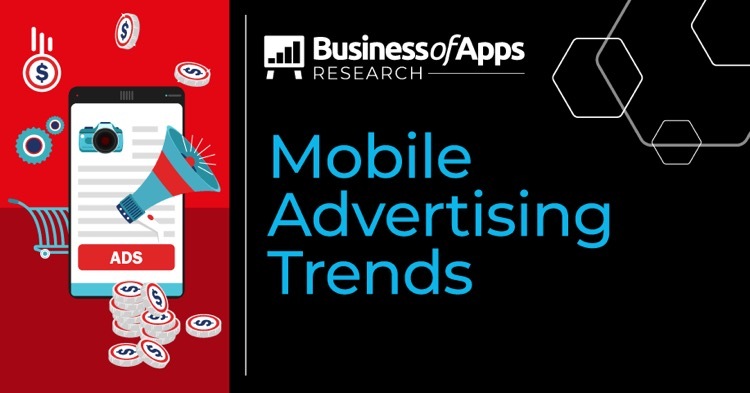Following the news stream for 2022 mobile advertising trends, naturally makes you focus on what’s happening today in the online advertising industry but to get a better appreciation of estimates for what will be happing in such a diverse and dynamic space as mobile advertising this year, let’s take a look quick look into 2020 and 2021.
As you all well remember, until February 2020 the world was minding its business with all its problems of that moment but the COVID-19 pandemic was that force that changed everything in a matter of weeks.
As people in the mobile ad business would confirm, by that moment more and more companies switching the bulk of their ad budgets from desktop to mobile, video format was already rising, and app marketers continued to shift their focus from the CPI (Cost Per Install) model to CPA (Cost Per Action) one. Research companies issued their estimates for what growth for the industry will look like next year.
Business as usual.
From February – most certainly from March and on – 2020 every party involved in the mobile advertising space was hit by the pandemic. Advertisers began to pull their budgets away, following the drop of demand on their products and services, CPM rates went down, and many businesses went from their growth plans to a basic surviving on a market.
In sync with the rest of the world, in 2021 which brought several vaccines and showed us that there a light at the end of the tunnel, at least good chances of coming out of the pandemic crisis. In 2021, riding on their record financial results for the entire 2020, Meta (I would prefer still call it Facebook) and Google were set to continue to grow in the economy that was really harsh for many companies and saw them going out of business really fast and with no return. The reason for the growth of all tech giants such as Facebook, Google, Amazon, Apple and Microsoft was that they had to provide a substitute for the way how people communicated, worked, and studied before COVID-19.
The world met 2022 with several micro-economic trends such as working from home, remote education, essentially no-existence of business travel, the tremendous psychological burden this pandemic had and continues to have on all of us.
Throughout 2020-2021 period several technologies, companies and mobile advertising trends set the tone for the entire mobile advertising marketplace. Let’s review them briefly.
TikTok
Well, where should we begin? I guess, by now, it would be save to say that all talks about the US government effort to force the company to be sold to Oracle (I know – what a weird choice for a new owner) are gone for good. Throughout the entire pandemic, TikTok saw both launches of new services and tools and several setbacks. It was banned in India in June, 2020, in August TikTok’s CEO Kevin Mayer resigns after 100 days, but the same year it launched $200 million fund for U.S. creators, introduced parental control, hit 2 billion downloads on the app stores.
In 2021 TikTok was the major media source for tens of millions to watch the Olympics coverage and by September reached 1 billion users. Also that year, TikTok’s users launched hashtag #TikTokMadeMeBuyIt that generated 7 billion + views and boosted sales of many brands. In October, it launched experimental feature that allows is users to tip creators and finally, in December it launched in beta Live Studio, a streaming software that would let users broadcast apps open on their computers, including games.
Looking into 2022, it’s obvious that TikTok is on the pass to mimic Facebook’s success story (both in scale and financially) but in a shorter period of time, doing its homework on mistakes Facebook did back in the day or simply leveraging different media and cultural environment we live in today. TikTok Ads, the advertising platform launched in 2019, will continue to be polished, equipped with new features and getting more and more data from TikTok users, to match Facebook Ads capabilities and efficiency.
Moving on to the next trend that dominates mobile today and will be next year.
Mobile streaming
According to Conviva, the census, continuous measurement and engagement platform for streaming media, global streaming increased by 21% YoY between Q3 2020 and Q3 2021. Mobile streaming goes up hand-in-hand with companies like Netflix, Hulu, Amazon, Peacock, Disney+ generating more and more unique video content, luring people to their platforms for movies and TV series they won’t find anywhere else. This presents more and more space for mobile advertising for brands, but on the other hand – competition for people’s attention continues to grow as well. At the end of the day, we all have that much awaking time to consume video content streamed to our smartphones and tablets.
Mobile e-Commerce
Mobile e-Commerce has been growing for the number of years and if you have been paying close attention to what country / market actually sets the tone for what’s coming next, you would see that quite often it’s China. And so one of the manifestations of this – Chinese latest e-commerce trend to broadcast live via mobile right from warehouses to sell various goods was released as TikTok Live Stream Shopping. Launched late in 2021, it remains to be seen how this new online shopping experience pans out for TikTok users, so watch the space.
Mobile Games as the next social network
Frankly, you don’t need a degree in economy to see that since Facebook grew as the major social media platform to this very day, not very much has changed on the social media landscape. No new major social media platforms have popped up, well – expect TikTok but still, as of today, Facebook (sorry – Meta) has the biggest number of users. So the competition comes from an unexpected direction – mobile games become the new social network arena. When people play mobile games, regardless of either sitting next to each other or hundreds miles away, they tend to socialize naturally and this is what many mobile game powerhouses begin to notice and build on it to improve experience they deliver.
Video content
Reading about video content being one of the mobile advertising trends for several years in a row, you maybe thinking that we shouldn’t be talking about it for 2022, but you would be wrong. It doesn’t look like any other medium will be able to surpass video this year and anytime soon as the most effective medium to deliver mobile ads. The Apple’s introduction of its ATT framework, that forced many mobile advertising platforms to get back to the drawing board and see how they can collect data themselves and not rely on a third-party provider such as Facebook, made it real clear – to compensate the absence of behavioral data, you need to come up with better video creatives to lure people towards your mobile app, your brand.
Personalization
Now, this one is easy. It doesn’t matter what year mobile ad trends we’re talking about, it will always be true – the better can app marketers walk the fine line between personalizing their ad messages and at the same time respecting people’s privacy, the better their chances to acquire loyal users for their apps and loyal customers for their brands.
5G mobile standard
If there is one mobile technology that has been covered really extensively, the one that facilitates mobile advertising growth and yet – still coming and not dominating mobile operators’ coverage, that would be 5G. In 2022, AT&T, and Verizon will launch their C-BAND spectrum, bought collectively for $68.8 billion in 2021. With wider adoption of 5G this year (by the end of 2021 only 660 million mobile subscriptions were 5G ones), expect more high-quality video ads in mobile games and apps in general.
Top Mobile Ad Networks
So these are some of the trends we believe will be shaping the year 2022.
If you want to contribute your view on mobile and in app advertising trends fill in the form here.
Mobile Advertising Thought Leaders
“Marketers’ toolboxes have been forever changed and expanded as we emerge from the pandemic and live in a vibrant creator economy world. Consumer behaviors, particularly their use of apps on mobile devices to conveniently conduct and enjoy all aspects of life, coupled with the proliferation of content creation platforms, are creating greater opportunities for marketers to more easily monetize and market to defined, engaged audiences.
Specifically, travel, fitness, medical, and second-language apps will continue to see download growth and significant consumer engagement post-pandemic. Duolingo went public after expanding its own monetization practices that made its 95% freemium model profitable. Ecommerce is another rapidly growing app vertical for marketers to pay attention to as consumers have adopted new habits and are accustomed to pandemic-era conveniences — 92% of consumers who tried online shopping in 2019 became converts, according to McKinsey.
We expect to see health and fitness apps continue to rise in popularity and evolve to appeal to different, savvier audiences. App Annie’s State of Mobile 2021 Report estimated that, in 2020, over 71,000 health and fitness apps were launched globally. The pandemic fueled the idea that ‘fitness can be anywhere’, and more mainstream apps have found ways to reach fitness enthusiasts with broader app selection and class instruction. Gone are the days where you need to book a class and/or head to the gym. With the increased selection of apps, instructors can reach a wider at-home audience and offer shorter, more snackable workouts that can be done in 10 to 15 minutes or less.”
“Podcasts will see a huge shift in mobile ad spend in 2022
Despite being around for the better part of the past two decades, podcasts have finally entered the mainstream in the past two years in an ‘audio renaissance’ that we only expect to continue. The growth and conversion activity happening will present huge opportunitIes for monetization and advertising, especially in the US and Southeast Asia, with eMarketer projecting $1.74 billion in U.S. podcast ad spend in 2022.
Along with advertising, influencer marketing will follow the growth and popularity of podcasts, particularly when it comes to Generation Z — a demographic in which over 70% of people are more likely to purchase a product when it’s recommended to them by the host of their favorite podcast. Over the course of the next few years, we expect podcasts — and their hosts in particular — to play a critical role in targeting younger listeners.”
“CTV/OTT subscription overload will create opportunities for more free channels, inviting a lot more advertising.
The difference from 2021 to 2022 in CTV and OTT streaming is that we’re going to see a lot more options for free channels that are ad-supported — and so a lot more advertising inventory will surface that hadn’t before. There is a limit to the number of subscriptions people are willing to take on for streaming services. To get their content, people are moving to AVOD. A recent Hub Research survey already shows that 41% of respondents prefer to watch free content with ads in every show. We expect to see this increase next year.
This additional inventory will not only give advertisers more opportunities to advertise on CTV, it will also have a profound effect on how they relate to advertising. The ‘C’ in CTV is allowing TV advertising to shift from branding into a key performance marketing channel. The analytics that advertisers are now being offered through — for example, OneView with Roku — are going to allow them to have a much different level of insight and bend their campaigns from brand awareness to brand experience and increasingly also direct response.”
“The mobile advertising landscape is changing, especially with the pandemic accelerating the shift to digital and the industry doubling down on privacy regulation. For instance, the launch of Apple’s App Tracking Transparency tool led to 96% of US consumers opting out of app tracking. As a result, the amount advertisers spend on iOS dropped by around a third, while simultaneously increasing by around 10% on Android. With more state, federal, and international governments enacting consumer privacy acts, I believe we’ll continue to see a shift in spend from iOS to Android in 2022.
This year, digital video ad spend in the U.S. was estimated at $55.34 billion. I foresee video continuing to remain strong, especially in-stream and rewarded video. Additionally, audio ads on mobile will make a move outside of podcasts and into experiences like gaming. And, of course, native on-device formats are certainly going to continue growing.
When it comes to the main platforms, innovation will come through offering new larger ad formats, enhanced creative and a focus on driving better performance, like reducing consumer friction, for advertisers to see the results they need. The reduction of impression-based attribution being “acceptable” is going to push these platforms to show better results and performance for media buyers.“
“2021 shook the digital ad space as a result of the recent privacy rules and the cost of acquisition.
Advertisers and the entire eco system were forced to adapt to the current situation by inventing and testing alternatives for new attribution and measurement techniques which will allow them to continue delivering performance oriented results.
The volatile cost of media in the traditional channels have led advertisers to test campaigns in emerging alternative channels such as: Tiktok , Snap and branding oriented activities rather than just running mainly FB and Google performance campaigns.
That is why a lot of advertisers will continue the exploration started in 2021, and invest much more heavily on a wider scope during 2022 with new ad styles such as CGC (Creator Generated Content) ads in order to maximize these creator based platforms. “
“Privacy changes will drive some of the most significant app advertising trends in 2022. SKAdNetwork, incrementality, and media mix modeling will continue to impact how marketers measure their campaigns, while a smaller pool of identifiable users and the need to utilize contextual data points will shape how they target audiences.
There will also be a lot of opportunities for advertisers who are willing to act quickly. Right now, for instance, no-ID iOS inventory is more than 50% cheaper than ID iOS inventory. This is a great chance for those who are willing to test new approaches for anonymous Apple users.”
“Social distancing in 2020-21 has accelerated the onboarding on mobile to either getting things done, to stay in touch more comprehensively, or to defeat boredom in the absence of sufficient offline alternatives. Hence, apps which fall into any of these three categories – e.g. On-Demand, Social Media, Gaming & Entertainment – will continue to do well as externalities continue to sponsor their adoption.
When it comes to Data & Privacy, the fundamentals might expand and be modified. However, the direction is clear: power and opt-in to the consumer. Hence, technology and innovation around first-party, or zero-party data, will be crucial to continue advertising campaigns on mobile both efficiently and with customer satisfaction.
The rise in LAT on iOS has brought a shift of advertiser budgets from SANs to mid-size platforms. While this is good to provide funding for distributed R&D and more competition to the benefit of the advertiser, what it reflects is the underlying need for know-how as well as operational resources to run successful performance marketing campaigns. Hence also in 2022 and in observation of the fierce velocity of change in our industry, there will be a dominant focus on deep expertise and outstanding execution for everything app.“
“User privacy continues to be the talk of the town. For programmatic, this means that we need first-party data to run more relevant campaigns. We can only do the best job for our advertisers if they connect us with the right sets of first-party data. So, we expect to see advertisers investing in the right tech and partners that can help them leverage that.
Also, now that we see opt-in rates are on the rise, I expect to see more focus returning to app retargeting. It’s now clearer what we can and can’t achieve with both LAT and non-LAT traffic, so advertisers will be back to invest big into retargeting and experimenting with blended campaigns for LAT traffic.“
“AdQuantum’s 2022 predictions
In 2022, we expect that the trend of 2022 on data privacy will continue. There will be no more transparency, there are chances to bypass it. Data attribution will continue moving away from precise towards probabilistic. The main focus will be on better metrics prediction. Economic models, A/B testing, first-party data gathering will help to gain the most accurate possible attribution. Also, the concept of Data Clean Rooms (DCRs) might come in handy in the post IDFA reality. This is a tool that gives us a user-level understanding of data without actual user-level access to it.
User privacy
Following Apple, Google promised to limit the transfer of the GAID advertising identifier for its Android operating system in 2022. Accordingly, marketers face an important task to get ready for total privacy and attribution restrictions. They will have to transfer all the experience gained from SKAN campaigns to Android ones.
IDFA and ATT
According to different sources, the percentage of ATT opt-in now varies from 30 to 40%. In the future, mobile developers can work on increasing this number through customization and clarifying to users why it’s important to consent.
Web-to-app campaigns
iOS 14 pushed the market to bypass the limitations that the SKAdNetwork framework puts on marketers. One of these solutions is web-to-app campaigns. The mechanic is that a user clicks on an ad and gets forwarded to a special landing page. Then he goes to the App Store and installs an app. The data about the user behavior is transmitted to Facebook Ads and can be used to optimize Facebook campaigns. This model allows you to see real-time performance data right in Ads Manager. There is an opinion that Apple will soon make web2app unusable by hiding user personal information. Still, at the moment this way of working with iOS traffic is attractive for mobile projects. Hence, you should pay attention to it and figure out if this approach works for your product.
NFT and Metaverse
In the era of blockchain technologies and cryptocurrency assets, we cannot ignore the metaverse and the NFT phenomenon spreading around the globe. In 2022, we expect a large number of both gaming and non-gaming titles based on non-fungible tokens technology. Simply put, this technology will allow its holders to officially own some content exclusively and receive tokens in return. This can later be used for stock or NFT marketplaces trading. There are arguments between experts if this is a really ground-breaking thing that will freshen up the gaming process or just marketing. Only time will tell.
M-commerce / grocery & food delivery
During the lockdown, most people started to actively use food delivery services. As a result, these two app categories turned out to be the fastest-growing in 2020-21. This user experience influenced the entire post-lockdown life. An increasing number of people prefer to buy products online rather than visit physical stores. In particular, this provoked the opening of a huge variety of new delivery services. Curious to see how the food/grocery delivery segment behaves in 2022.
Therefore, we are expecting that mobile marketers should learn how to promote mobile games built with blockchain technologies and master their skills in marketing for food delivery apps.“
“Social distancing in 2020-21 has accelerated the onboarding on mobile to either getting things done, to stay in touch more comprehensively, or to defeat boredom in the absence of sufficient offline alternatives. Hence, apps which fall into any of these three categories – e.g. On-Demand, Social Media, Gaming & Entertainment – will continue to do well as externalities continue to sponsor their adoption.
When it comes to Data & Privacy, the fundamentals might expand and be modified. However, the direction is clear: power and opt-in to the consumer. Hence, technology and innovation around first-party, or zero-party data, will be crucial to continue advertising campaigns on mobile both efficiently and with customer satisfaction.
The rise in LAT on iOS has brought a shift of advertiser budgets from SANs to mid-size platforms. While this is good to provide funding for distributed R&D and more competition to the benefit of the advertiser, what it reflects is the underlying need for know-how as well as operational resources to run successful performance marketing campaigns. Hence also in 2022 and in observation of the fierce velocity of change in our industry, there will be a dominant focus on deep expertise and outstanding execution for everything app.“
“Advertisers are getting used to the privacy-centric ad landscape
Last year, budgets were slowly but surely migrating from iOS to Android, especially in the second part of the year. In 2022, I predict that iOS will take some of it back, but I’m not expecting it to get back to the proportions that we had pre-2021 – when advertisers were spending significantly more on iOS than on Android.
Advertisers are more familiar now with the new privacy-centric landscape on iOS and they can use SKAdNetwork and ”Probabilistic” attribution (I don’t think it’s going away in 2022) to acquire new users. Furthermore, new adtech tools will emerge to help make advertisers’ lives much easier.
On Android, on the other hand, we should expect more changes aimed at increasing end-user privacy. The changes introduced in Android 12 (zeroed advertising ID for opted-out users) will not be the only privacy-centric update from Google.
More blockchain games on mobile
An increasing proportion of hyper-casual developers are looking at the emergent trend of blockchain-based games.
Super talented companies like Voodoo, Homa Games, Lucky Kat, Game Jam, Loop Games, and Gismart have recently announced that they are working on some form of blockchain gaming project. No doubt, there’ll be more announcements from major studios in this field to come! Additionally, I think we’ll see a couple of comebacks in this new space from founders that sold their companies in the past.
However, whether or not these types of games will be successful on mobile depends primarily on whether and how platform owners (Google and Apple) integrate key blockchain technologies into their stack and terms of service. Apple, for example, still doesn’t allow developers to integrate alternative payment methods, meaning users can’t make transactions with cryptocurrency. If Apple eventually allows this major change to its ecosystem, it will incrementally boost the mass appeal and adoption of blockchain games. .”
“I expect to see big shifts from Apple taking a stand against app “surveillance marketing” (just look at the new App Privacy Reports in iOS 15.2). I think we’ll see Apple give consumers more tools like these to reveal what “fingerprint” info each app share with 3rd party ad SDKs, and the ability to block those 3rd parties from receiving that information. Basically Apple is going to indirectly pressure app marketers to compete on privacy-first growth strategies. This will increase adoption of app growth tactics like app QR codes, app install banners, ASO/SEO, and of course, Apple Ads!“
“As an app marketer you need to invest quite a bit into targeting users and monetizing them over longer periods of time without alienating them. Cross promotion is one way to do that, but you need to limit that risk of alienating the user by segmenting based on user behavior and profile, testing different ad formats, and considering your position in the waterfall to be efficient in securing a user’s interest from one of your apps to the next.
At Adikteev, we’re seeing advancements in diagnosing and predicting user behavior through data science, making growth teams more accurate in anticipating actions: what each user will do and when they’ll do it. This creates the opportunity to further pinpoint the next app that the user is most likely to appreciate within your portfolio, potentially even across genres. It also opens up opportunities for predicting user churn, which allows marketers to continue maximizing about-to-churn users’ LTV across an entire portfolio of apps. Additionally, if you have a native placement for cross-promotion you can avoid the waterfall entirely to save on ad costs and competition for your user’s attention. If you tie all of this together, it becomes an efficient channel for retaining your own users at the portfolio level when they would otherwise churn to a competitor’s game. The tangible business impact to growth teams can be measured on a CPI basis – cross promotion CPI can be half that of external UA, which becomes more attractive particularly when dealing with the tracking limitations on iOS.“
“Re-acquiring users is the new “re-engagement”. We saw a huge uptick in installs across apps that helped consumers during the pandemic, such as food delivery, streaming services, education, among others – and that growth has steadily continued. Due to the high level of competition, costs, and content cycles, these apps are experiencing shifts in their re-acquisition cycles. Retaining users in these key verticals is where many mobile marketers will need to focus their advertising efforts.
App developers have finally unlocked alternative payment options to offer users outside of Apple’s App Store. While we expect many to take on innovative new payment models, this is expected to create a bit of a “clunky” acquisition funnel. While the App Store tax is daunting, it’s hard to beat the convenience and seamless user experience. We expect some apps to shift their acquisition strategies in 2022, but foresee minor challenges getting users to convert initially. Additionally, app developers should be on the lookout for bad cards on file or chargebacks when subscriptions renew.
No one is going to push monetization as hard as gaming app marketers in 2022. With industry-renowned milestones such as the Epic Fight in the rearview, it’s no surprise that gaming marketers are expected to get aggressive about driving growth.
One of the biggest unknowns we still have to be aware of is Apple’s approach to ATT. While it has spawned innovation from some, the mobile advertising industry has largely gone back to business as if nothing happened. Perform[cb] is driving SKAdNetwork installs on behalf of many clients, but our team is still seeing the bulk of acquisition happening through the MMP methodologies.
I’m sure we’re all familiar with the new term “Meta” coined by Facebook. The metaverse will receive much more attention this year, but it’s expected for companies to continue to push augmented reality as a stepping stone to our fully digitized alternative lives.
The finance vertical will continue to be a hot market for all, with new entrants and innovative consumer product offerings coming to light this year. “





















